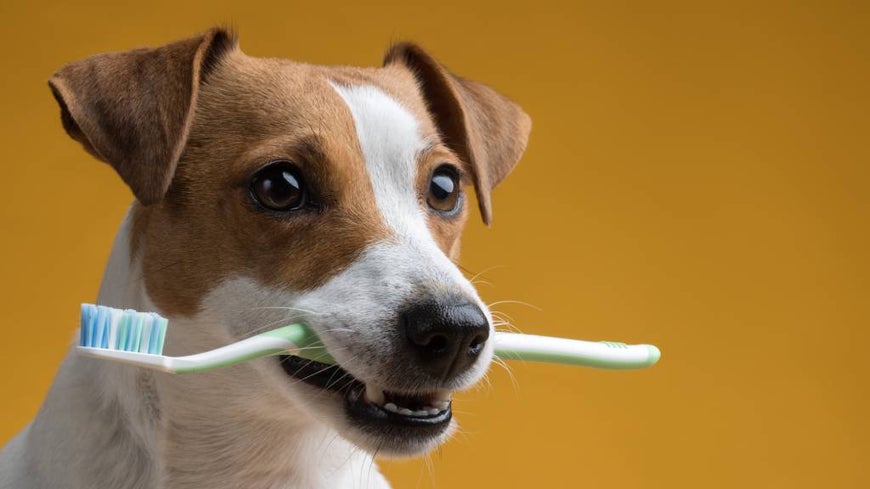Caring for your pet’s chompers

Written by Monique Butterworth for Australian Seniors
Dental disease is the most prevalent health condition affecting pets in Australia. “A staggering 70-80% of cats and dogs will experience some form of dental disease in their lifetime,” says Petstock Vet general manager Dr Sasha Nefedova.
“Periodontal disease is a progressive condition affecting your pet’s gums and surrounding bone. It develops in four stages, with the initial stage being the mildest and most easily treatable.”
Symptoms may include bad breath, plaque and tartar build-up, loss of appetite, difficulty chewing, eating and bleeding gums. “Pets may not show any signs of dental disease and feel ‘silent pain’ just like when we have a moderate toothache,” warns Dr Nefedova. “That’s why it’s important to talk to your vet about your pet’s teeth and get them checked during your pet’s routine check-up or vaccination.”
Like us, periodontal (gum) disease is typically caused by plaque, a sticky film on teeth that bacteria can cling to. Food particles, drool and microbes stick to the teeth surface and if not removed, can calcify into tartar above and below the gum line.
If left untreated, over time it can lead to the destruction of supportive tissue and jawbone, bad breath and loss of teeth. Worse still, toxins from any gum infections may be absorbed into the bloodstream and can cause permanent or fatal organ damage to the kidneys, liver and brain.
Ideally, dental care needs to be implemented and continuous from when your pet is young, because by the time your pet is a senior, effects of dental neglect will most likely be obvious.
Is your pet in pain?
Some signs to look out for that could indicate your pet is in pain include loose teeth, excessive drooling, dropping food when eating or reluctant to chew hard food, inflamed, receding or blood-stained gums, behavioural changes, pain when handled around the head, facial swelling and pawing at the mouth.
“It’s important to note that dental disease causes pain and discomfort at any stage. Seeking prompt veterinary advice and early treatment is crucial to prevent the condition from worsening,” says Dr Nefedova.
Luckily, if your pet is showing signs of gum disease, starting treatment immediately before further or irreversible damage occurs is fairly straightforward.
“Professionals recommend at least one check-up every six months, along with routine dental cleaning under anaesthesia when necessary,” Dr Nefedova says. “It is also more cost effective to clean teeth then perform longer dental procedures once dental disease has set in, much like our own dental needs.”
You may consider cleaning your pet’s teeth and gums at home, establishing a brushing routine with pet-friendly toothbrushes and toothpaste. Additionally, consider dental wipes, mouth freshening water additives or fresh breath foam. Consulting a vet for personalised advice is recommended. Cat teeth may be trickier to clean than dogs – a variety of toothbrush styles are available or a simple damp cloth wrapped around your finger could do the trick.
For all pets, some products are a big no-no. “Avoid using human toothpaste, as it may contain xylitol, which is toxic to pets. Also, be cautious with hard objects that pets may chew, as aggressive chewing can lead to broken teeth.”
Bones for cats and dogs
Likewise, feeding pets raw bones can be an issue. Although raw bones can be great for removing bacteria around the teeth thanks to their texture and flexibility, always ensure the size of the bone is suitable for the size of your dog or cat. (Never offer cooked bones as these can splinter and cause serious harm.)
“Feeding raw bones that are too large can cause issues like fractured teeth. A newly-broken tooth that exposes the nerve is painful and requires immediate attention,” says Dr Nefedova. “After several days the nerve will die allowing infection to enter the tooth and root, meaning an extraction is required.”
Left untreated, these teeth can lead to abscesses and cause bacteria to spread to major organs such as the kidney, liver or heart, she adds. “Keeping up your pet’s chewing habits with chew toys or treats for dental health to gnaw could be better than raw bones. However, a waning interest in chewing is normal as a dog ages.”
The prevalence of dental disease is similar in both cats and dogs and rises as pets age. “Dental disease can affect any breed; however, some small breed dogs are more likely to have dental disease or develop disease quicker than larger breeds,” says Dr Nefedova.
Dental diet
Fruit and vegetables come with teeth-cleaning benefits and help manage chronic oxidative stress known to cause gum disease. Many dogs love snacking on carrots, apples and pumpkin, which are easy to eat and will not stick to teeth. Like raw bones, consider the size of your dog and note these treats (as an estimate) should only account for around 10% of your pet’s daily intake. Make sure you always get professional advice regarding your pet’s health.
Adding a probiotic such as yoghurt to your pet’s diet could help rid your dog’s mouth of harmful bacteria, and prevent inflammation developing. A diet that provides ‘dental exercise’, such as chewy, fibrous food, can be essential.
“Specially formulated dental kibble can contribute to healthy oral hygiene by reducing the formation of plaque and tartar,” says Dr Nefedova. “Diet changes should be gradual and done under the guidance of a pet professional.”
Healthy pets
The Australian Seniors Series: For the Love of Pets Report 2024 finds…
- 9.7 hours a week is spent, on average, exercising, grooming, playing and attending to the needs of our pets
- 46% of dog owners buy health and safety products for their pets
- 38% of cat owners buy health and safety products for their pets
21 Jun 2024